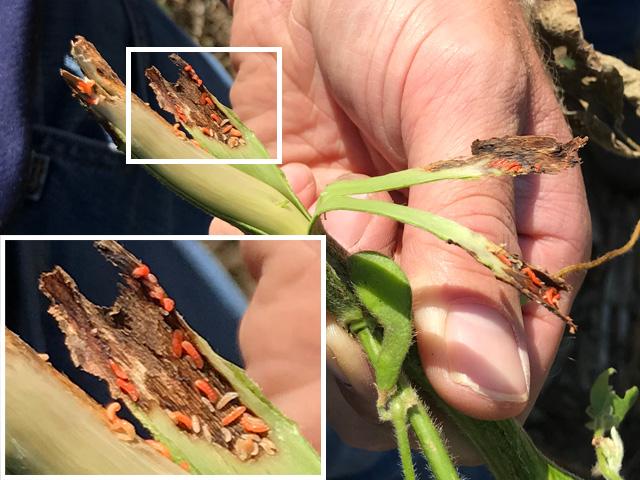Year's First Soybean Gall Midge Trapped
Soybean Gall Midge Appears in Nebraska Earlier Than Usual
JEFFERSON CITY, Mo. (DTN) -- Soybean growers in east-central and northeast Nebraska should begin scouting for soybean gall midge sooner rather than later this year. Researchers involved in a multi-state monitoring network sent out an alert June 5 that the pest has already emerged at five trapping sites.
"We detected the first adult gall midge on May 26, but it was a male, which doesn't infest soybean plants," said Justin McMechan, crop protection and cropping systems specialist at the University of Nebraska. "The first female was detected on May 31 near Mead in east-central Nebraska, and by June 4, soybean gall midge adults appeared in traps near Wahoo, Havelock and Weeping Water as well as in northeast Nebraska near Randolph."
Soybean gall midge is a tiny fly that lays its eggs on the stems of young soybeans plants. After the eggs hatch, the larvae feed on the tissues within the stem under the epidermis, disrupting nutrient and water movement. As they mature, the maggots turn from white to orange. Infested plants can quickly wilt and die or break off at the feeding site. Significant yield reductions may occur, especially at the field edge.
Plants are susceptible to infestation when they begin to develop small cracks or fissures on the stem at the base of the plant, typically at the V2 growth stage. These provide an entry point for females to lay eggs.
In a phone interview with DTN, McMechan expressed some concern that early planted soybeans in the region may be more vulnerable to infestation this year. Early cold weather followed by hot, dry conditions has kept many fields from developing as they would under more-normal conditions.
"A lot of those beans aren't as far along as we'd like on those early planting dates, and that's not good for growers," he said. "With a lot of those beans sitting at the V2-V3 growth stage, it puts them in a more susceptible window for potential injury and plant death."
While orange larvae were first observed in Nebraska in 2011, no specimens were collected or stored. It wasn't until 2018 that soybean gall midge was determined to be a new species that had not been documented. Since then, the Soybean Gall Midge Alert Network has found the pest in 155 counties in Iowa, Minnesota, Missouri, Nebraska and South Dakota, including 15 new counties last year.
P[L1] D[0x0] M[300x250] OOP[F] ADUNIT[] T[]
McMechan said this year's initial emergence is slightly ahead of previous seasons. Once emergence begins, it typically continues for 25 to 35 days, though some overwintering sites have seen emergence last for 44 days.
"We would expect that Minnesota and Iowa will begin picking up emergence in the next two weeks, but it could be sooner," he said. "Once emergence occurs, we start to see white larvae showing up in soybean stems within nine to 12 days."
Management for soybean gall midge has been a hit-or-miss proposition. Chemical control has shown some results, but foliar-applied insecticides have been inconsistent between locations and years. McMechan said growers should only consider applying if they have a history of issues with soybean gall midge and observed the pest in an adjacent field the previous season. He recommended using a combination product that contains a pyrethroid.
Since soybean gall midge is a field edge-infesting pest, growers may only need to treat the first 60 to 120 feet of a field edge. "The first four rows would be the best place to look for the larvae," McMechan added, noting that a foliar treatment prior to V2 isn't necessary because the plants have not developed the fissures or cracks at the base of the stem.
Infestation can also be controlled by covering the base of the soybean plants with soil. This "hilling" has been found to be a very effective strategy with almost complete control of soybean gall midge. However, the practice is difficult to implement when soybean plants are small, as they can easily be completely covered by soil.
Researchers also recently discovered a tiny parasitic wasp that may help provide biological control of soybean gall midge. Read more about it here: https://www.dtnpf.com/…
SCOUTING TIPS
The following are some soybean gall midge scouting tips.
-- Scout edges of soybean fields adjacent to fields that were planted to soybeans the previous year, especially if they had a gall midge infestation.
-- Focus on fields that are V2 or older -- that's when the soybean stem starts to crack along the surface near the soil line. The adult midge lays eggs in these fissures.
-- Look for dark brown or black discoloration of the base of the stem. Scrape the exterior layer of the stem away to reveal larvae that start white and turn orange as they mature.
You can set up an alert notification of gall midge discovery here: https://soybeangallmidge.org/…
Jason Jenkins can be reached at jason.jenkins@dtn.com
Follow him on Twitter @JasonJenkinsDTN
(c) Copyright 2023 DTN, LLC. All rights reserved.






